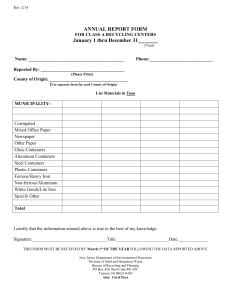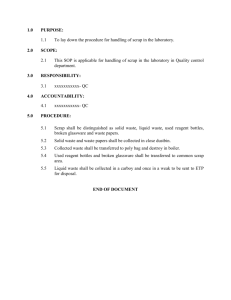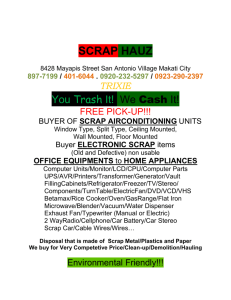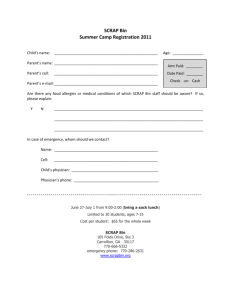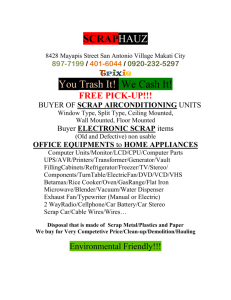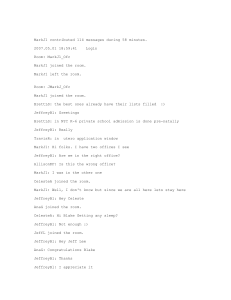Scrap and Waste Recycling Facilities
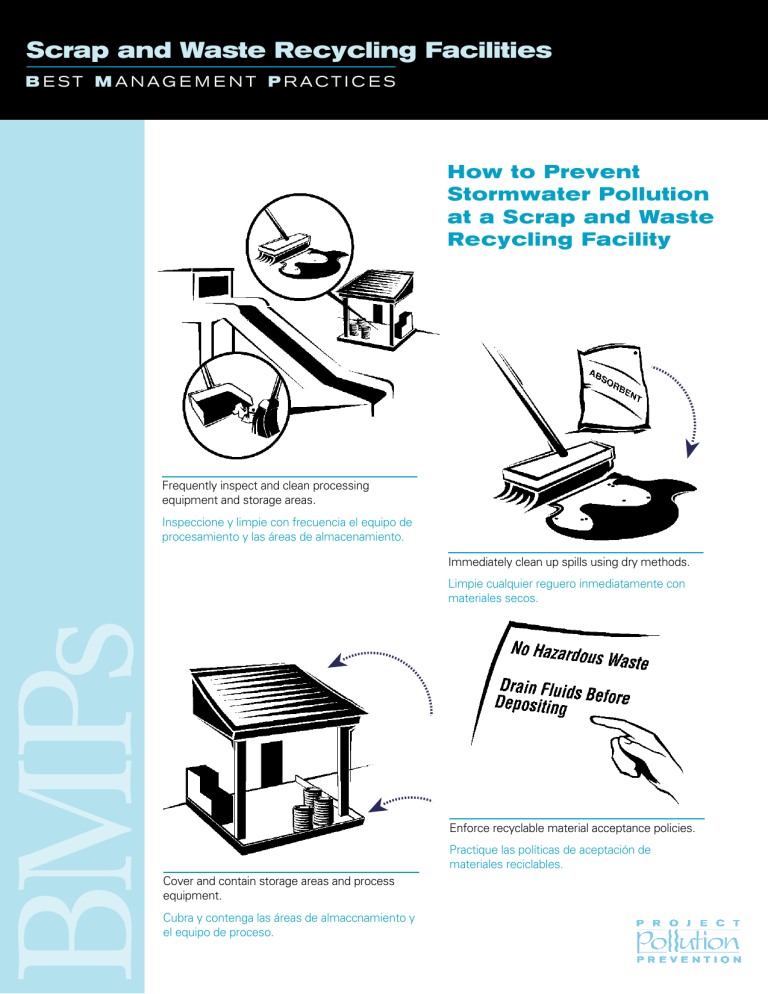
Scrap and Waste Recycling Facilities
B E S T M A N A G E M E N T P R A C T I C E S
How to Prevent
Stormwater Pollution at a Scrap and Waste
Recycling Facility
Frequently inspect and clean processing equipment and storage areas.
Inspeccione y limpie con frecuencia el equipo de procesamiento y las áreas de almacenamiento.
Immediately clean up spills using dry methods.
Limpie cualquier reguero inmediatamente con materiales secos.
Cover and contain storage areas and process equipment.
Cubra y contenga las áreas de almaccnamiento y el equipo de proceso.
Enforce recyclable material acceptance policies.
Practique las políticas de aceptación de materiales reciclables.
BMPs
B E S T M A N A G E M E N T P R A C T I C E S
■
Inbound Material Control
Conduct routine preventative maintenance of equipment, control measures such as oil/water separators, and storage and containment areas. Conduct periodic nondestructive testing (NDT) of all bulk storage tanks for signs of deteriorating structural integrity.
Establish for rejecting or inspecting materials. Create a program for inspecting, handling, storing and disposing of lead-acid batteries, hazardous wastes, and other nonhazardous residual fluids. Procedures should describe handling of cracked and broken batteries and disposal of leaking battery acid. Give guidelines for properly handing industrial turnings and cuttings to prevent cutting oils and metallic fines from coming in contact with runoff.
Encourage suppliers of scrap, waste and other salvageable materials to drain residual fluids and reduce the volume of semi-solid and liquid residues in aluminum and plastic containers prior to bringing the material to the facility.
■
Facility Operations
Drain and collect liquids in a designated area. Put a cover over and secondary containment around all liquid waste transfer facilities.
Conduct processing operations indoors or place process equipment under cover and prevent runoff from coming in contact with the equipment. Stabilize high traffic areas around the equipment.
Prohibit illicit discharges and illegal dumping to floor drains that are connected to the storm drain system.
■
Material Storage
Store all materials and waste indoors or in covered areas with curbing, berms or other containment measures.
Surfaces of secondary containment areas should be adequately sealed to prevent leaks. Store the equivalent of one day’s average volume of lightweight recyclable materials indoors. Separate all scrap batteries from other scrap materials and segregate hazardous and flammable wastes to comply with National Fire Protection
Association (NFPA) guidelines.
Store materials in appropriate containers near the point of use or production of the materials (i.e. shredded materials and fluff). Make sure that all storage containers and drums are in good condition and meet NFPA guidelines.
Clearly label all containers and include necessary warnings and special handling instructions.
In the storage areas, put individual containers on pallets.
Limit the stack height of individual containers/drums and put straps or plastic wrap around the drums to provide stability. Provide adequate clearance to allow material movement and access by material handling equipment.
■
Inspections and Maintenance
Regularly inspect material storage, handling and transfer areas, equipment, containment areas, storage and waste containers/drums, and bulk liquid tanks for spills, leaks, signs of corrosion, worn parts or components, deterioration of flanges, and leaking seals and gaskets.
Immediately repair any problems.
■
Spills and Facility Clean-up
Establish spill prevention and response procedures and use dry methods to clean up spills. Keep an adequate supply of dry clean up materials readily accessible.
Schedule frequent cleaning of accumulated fluids and particulate residue around all scrap processing equipment, storage containers and high traffic areas.
Regularly sweep all traffic and storage areas to minimize particulate and residual materials buildup. Prohibit washing down of material storage and tipping floor areas, unless approval is granted by the wastewater treatment plant to discharge wash waters to the sanitary sewer.
■
Numbers to Call for More
Information
Department of Toxic Substances Control (hazardous waste questions) (916) 324-1826
Regional Water Quality Control Board,
Los Angeles Region (213) 266-7500
Check the phone book for your local wastewater treatment plant.
If you have questions about this fact sheet, please contact:
City of Los Angeles
Department of Public Works
Stormwater Program
1-800-974-9794
Printed on recycled paper.
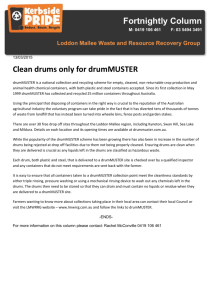
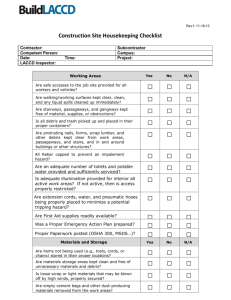
![You`re invited to celebrate [child`s name]`s birthday at SCRAP! What](http://s3.studylib.net/store/data/007177272_1-c15601fb9e11b26854f13f1982e634e8-300x300.png)
